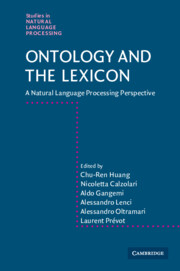Book contents
- Frontmatter
- Contents
- Contributors
- Preface
- Part I Fundamental aspects
- 1 Ontology and the lexicon: a multidisciplinary perspective
- 2 Formal ontology as interlingua: the SUMO and WordNet linking project and global WordNet
- 3 Interfacing WordNet with DOLCE: towards OntoWordNet
- 4 Reasoning over natural language text by means of FrameNet and ontologies
- 5 Synergizing ontologies and the lexicon: a roadmap
- Part II Discovery and representation of conceptual systems
- Part III Interfacing ontologies and lexical resources
- Part IV Learning and using ontological knowledge
- References
- Index
2 - Formal ontology as interlingua: the SUMO and WordNet linking project and global WordNet
from Part I - Fundamental aspects
Published online by Cambridge University Press: 06 July 2010
- Frontmatter
- Contents
- Contributors
- Preface
- Part I Fundamental aspects
- 1 Ontology and the lexicon: a multidisciplinary perspective
- 2 Formal ontology as interlingua: the SUMO and WordNet linking project and global WordNet
- 3 Interfacing WordNet with DOLCE: towards OntoWordNet
- 4 Reasoning over natural language text by means of FrameNet and ontologies
- 5 Synergizing ontologies and the lexicon: a roadmap
- Part II Discovery and representation of conceptual systems
- Part III Interfacing ontologies and lexical resources
- Part IV Learning and using ontological knowledge
- References
- Index
Summary
WordNet
WordNet is a large lexical database for English. With its broad coverage and a design that is useful for a range of natural-language processing applications, this resource has found wide general acceptance. We offer only a brief description here and refer the reader to Miller, 1990 and Fellbaum, 1998 for further details. WordNet's creation in the mid-1980s was motivated by current theories of human semantic organization (Collins and Quillian, 1969). People have knowledge about tens of thousands of concepts, and the words expressing these concepts must be stored and retrieved in an efficient and economic fashion. A semantic network such as WordNet is an attempt to model one way in which concepts and words could be organized.
The basic unit of WordNet is a set of cognitively equivalent synonyms, or synset. Examples of a noun, verb, and adjective synset are {vacation, holiday}, {close, shut}, and {soiled, dirty}, respectively. Each synset represents a concept, and each member of a synset encodes the same concept. Differently put, synset members are interchangeable in many contexts without changing the truth value of the context. Each synset also includes a definition, or ‘gloss’, and an illustrative sentence.
The current version of WordNet (3.0) contains over 117,000 synsets that are organized into a huge semantic network. The synsets are interlinked by means of bidirectional semantic relations such as hyponymy, meronymy, and a number of entailment relations.
- Type
- Chapter
- Information
- Ontology and the LexiconA Natural Language Processing Perspective, pp. 25 - 35Publisher: Cambridge University PressPrint publication year: 2010
- 13
- Cited by



